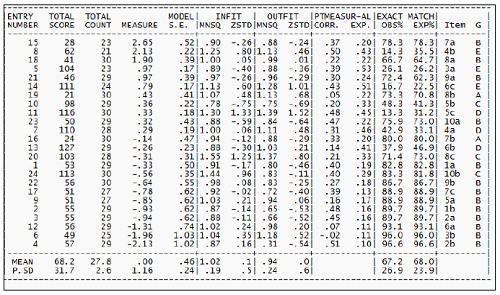
Development of Test Instrument to Assess Students' Understanding on Macroscopic, Sub-Microscopic, and Symbolic Levels of Acid-Base Topics Using Rasch Model
Abstract
Keywords
Full Text:
PDFReferences
Bohori, M., & Liliawati, W. (2019). Analisis penguasaan konsep siswa menggunakan Rasch Model pada materi usaha dan energi. Prosiding Seminar Nasional Fisika, 0, 138–143. http://proceedings.upi.edu/index.php/sinafi/article/view/579
Diputera, A. M. (2019). Teori Penilaian Tes Essai Atau Uraian. Journal Reseapedia, 1(1), 1.
Eliza, W., & Yusmaita, E. (2021). Pengembangan Butir Soal Literasi Kimia pada Materi Sistem Koloid Kelas XI IPA SMA/MA. Jurnal Eksakta Pendidikan (Jep), 5(2), 197–204. https://doi.org/10.24036/jep/vol5-iss2/621
Jariati, E., & Yenti, E. (2020). Pengembangan E-Magazine Berbasis Multipel Representasi untuk Pembelajaran Kimia di SMA pada Materi Larutan Elektrolit dan Non Elektrolit. Journal of Natural Science and Integration, 3(2), 138. https://doi.org/10.24014/jnsi.v3i2.10131
Nisa, D. Q., & Yusmaita, E. (2022). Pengembangan Butir Soal Literasi Kimia pada Topik Larutan Elektrolit dan Non Elektrolit Kelas X SMA / MA Development of Chemical Literacy Items in Electrolyte and Non Electrolyte Solution Topic for Class X SMA / MA. Entalpi Pendidikan KImia, 17, 49–57.
Physics Education Journal. (2018). Universitas Papua. Physics Education Journal, 1(1), 12–21. i.yusuf@unipa.ac.id
Planinic, M., Boone, W. J., Susac, A., & Ivanjek, L. (2019). Rasch analysis in physics education research: Why measurement matters. Physical Review Physics Education Research, 15(2), 20111. https://doi.org/10.1103/PhysRevPhysEducRes.15.020111
Pratama, D. (2020). Analisis Kualitas Tes Buatan Guru Melalui Pendekatan Item Response Theory (IRT) Model Rasch. Tarbawy : Jurnal Pendidikan Islam, 7(1), 61–70. https://doi.org/10.32923/tarbawy.v7i1.1187
Sabekti, A. W., & Khoirunnisa, F. (2018). Penggunaan Rasch Model Untuk Mengembangkan Instrumen Pengukuran Kemampuan Berikir Kritis Siswa Pada Topik Ikatan Kimia. Jurnal Zarah, 6(2), 68–75. https://doi.org/10.31629/zarah.v6i2.724
Sudarmin, S. wardani I. (2015). Pengembangan Asesmen Autentik Pada Materi Interaksi Makhluk Hidup Dengan Lingkungan Untuk Meningkatkan Kemampuan Berpikir Kritis Siswa. Unnes Science Education Journal, 4(2), 1253¯ 1260.
Sumintono, B. . W. W. (2015). Aplikasi Pemodelan Rasch pada Assessment Pendidikan. Trim Komunikata.
Sumintono, B., & Widhiarso, W. (2013). Aplikasi Model Rasch Untuk Penelitian Ilmu-Ilmu Sosial.
Wang, Z., Chi, S., Luo, M., Yang, Y., & Huang, M. (2017). Development of an instrument to evaluate high school students’ chemical symbol representation abilities. Chemistry Education Research and Practice, 18(4), 875–892. https://doi.org/10.1039/c7rp00079k
Wei, S., Liu, X., Wang, Z., & Wang, X. (2012). Using rasch measurement to develop a computer modeling-based instrument to assess students’ conceptual understanding of matter. Journal of Chemical Education, 89(3), 335–345. https://doi.org/10.1021/ed100852t
Zahro’, S. F., & Ismono, I. (2021). Analisis Kemampuan Multirepresentasi Siswa Pada Materi Kesetimbangan Kimia di Masa Pandemi Covid-19. Chemistry Education Practice, 4(1), 30. https://doi.org/10.29303/cep.v4i1.2338
DOI: http://dx.doi.org/10.31258/jes.7.2.p.282-295
Refbacks
- There are currently no refbacks.
Copyright (c) 2023 Arifah Sulvianti

This work is licensed under a Creative Commons Attribution 4.0 International License.
Publisher: FKIP Universitas Riau












